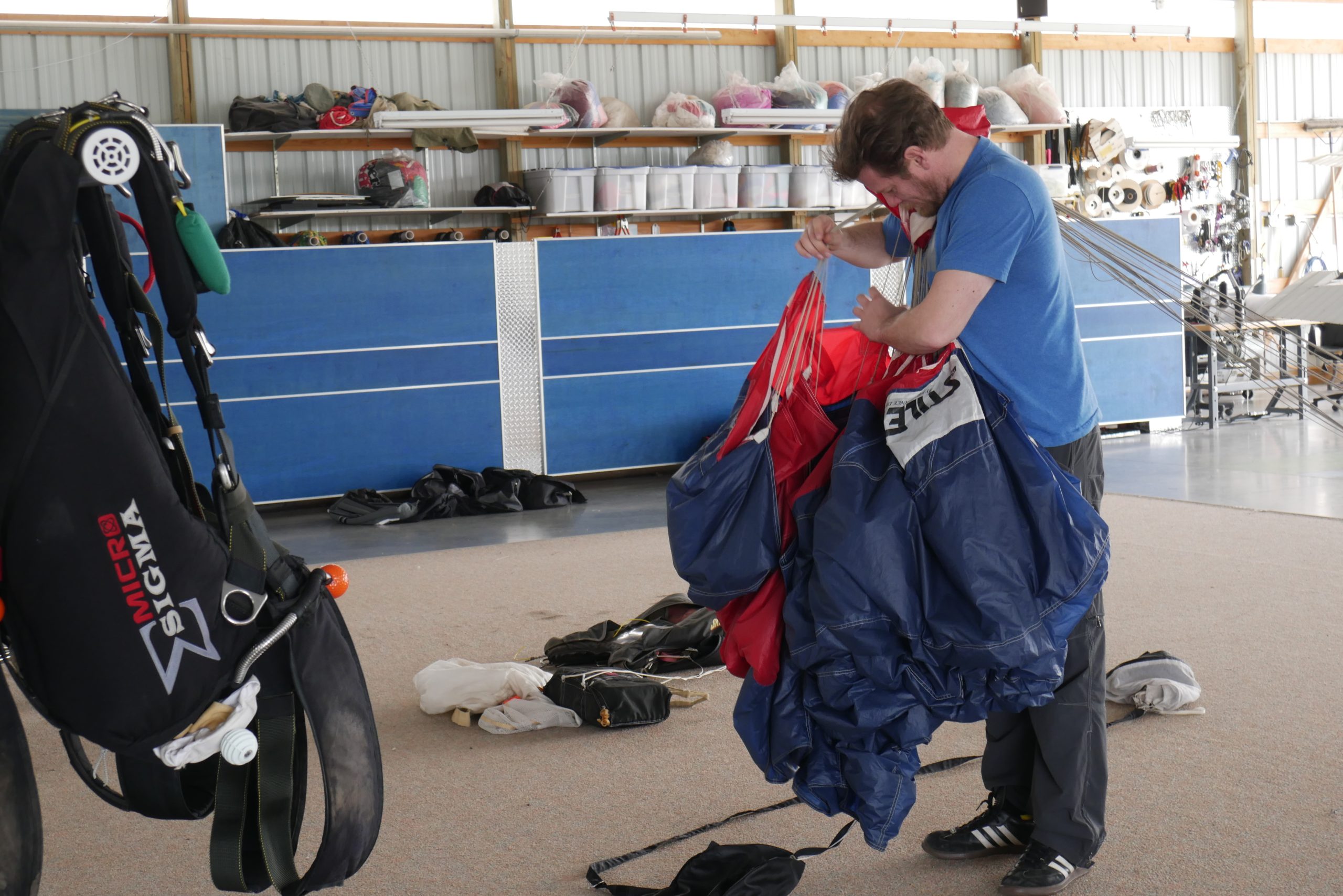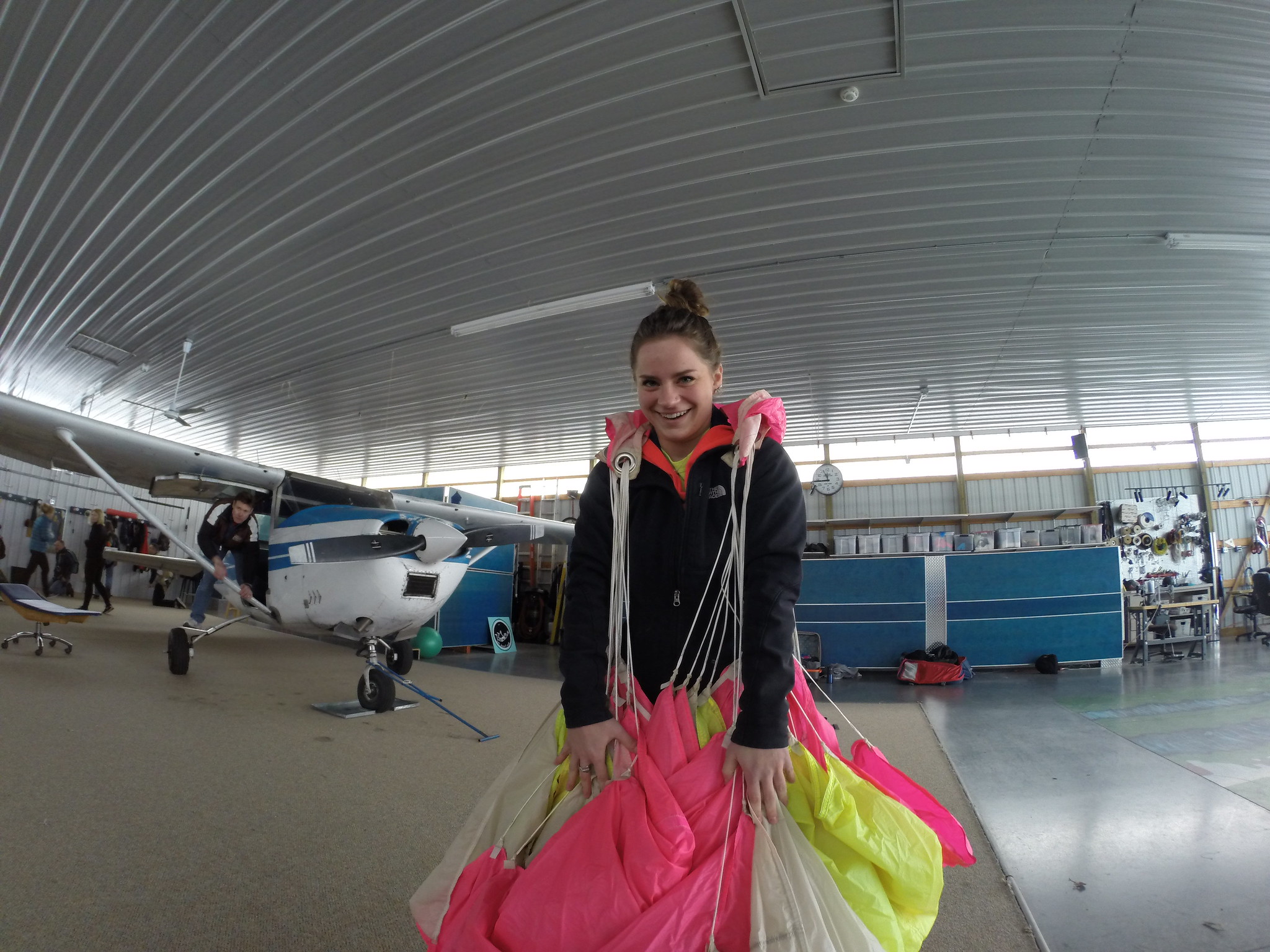A Day In The Life Of A Parachute Packer
General
Posted by: Wisconsin Skydiving Center 6 days ago
It’s 8 am at the dropzone: the first load is gearing up and parachute packers are already on the mat, ready to crush the busy day ahead. How do these essential DZ family members know how to pack a parachute? It’s a requirement for earning your solo skydiving license – we all know how to pack our own parachute. But some people fall in love with the methodical process of packing a parachute and decide to pursue it as a form of income, oftentimes to fund their skydiving habit.
Parachute packers are typically super chill and always eagle-eyed. They are some of the first-in, last-out people on the DZ, and we couldn’t do what we do without them. Read on for a sneak-peek into a day in the life of a parachute packer – some of the most appreciated and necessary people at the dropzone!

Who Packs Your Parachute?
A parachute packer is someone who dedicates themselves to learning the ins and outs of packing a canopy used for skydiving, and who utilizes those skills to pack for others.
Parachute packers are overseen by Senior or Master riggers who are certified by the Federal Aviation Administration (FAA). Senior riggers have more extensive training than packers and can perform minor parachute repairs. Master riggers hold the highest credentials and can perform more significant repairs, pack reserve parachutes, and make modifications to the harness and container (the “backpack” part of the rig).
Parachute packers can pack full-time or part-time – often just on the weekends – and come from all walks of life, just like skydivers. Do you have to skydive to be a packer? Nope! Some of the best packers out there fell in love with the on the ground operations of the sport and not the sky. If jumping isn’t your thing, being a packer is a great way to still integrate into the community!
What Does A Busy Day Look Like For A Packer?
Packers find satisfaction in their work – they’re enabling people to do something they love over and over again throughout the day. Plus, if they’re packing tandem rigs, they’re making it possible for people to experience the beauty of the skies for the first time, which is pretty darn special to be part of! Although the benefits far outweigh the packer’s cost of commitment, it’s still strenuous work!
8 am. Packers come locked and loaded with water, snacks, energy drinks and all the good vibes. As the first load of jumpers descend, packers wait expectantly for go time.
9 am. Rigs get set down in front of them and they start methodically working their magic.
12 pm. The heat of the day creeps in, but packers don’t let up – they maintain their pace to keep the mat clear. Packers socialize with the students and licensed jumpers they’re packing for, but keep their eyes on the prize of finishing their work. As each pack job is complete, they reorganize their mat in anticipation of the next.
8 pm. At the end of the day, packers are sore and their muscles and minds are soon ready to rest. Once the sunset load lands, and those final rigs come in, the day can come to an end. Whew! Then, they’ll crash HARD, get up the next day, and do it all again!
How many pack jobs does a packer do on a busy day? Each packer’s pace is different, as is demand coming from the dropzone. For some packers, a 20 pack job day is top notch, while others can soar through 50!
How Much Is A Parachute Pack?
Parachute packer jobs are one of the most lucrative positions to hold in the skydiving industry! Parachute packers are paid PER pack, meaning, if they’re efficient at what they do, they’ll make more money. Packer pay depends on where they’re located, what they’re packing, and who they’re packing for. Baseline parachute packing pay is as follows:
Tandem rigs. Generally between $12 and $15, with the packers paid by the dropzone.
Student rigs or rental rigs. Many dropzones that teach people to skydive solo have student gear available for rent. These pack jobs are anywhere between $7 and $10, with the packers paid by the dropzone.
Sport rigs. For licensed skydivers who do not pack for themselves and are opting to use a packer, the standard is $10. Tipping is appreciated, but never expected. Packers are paid directly by the licensed skydiver.
Full RDS rigs. This is a type of sport rig in which the entire deployment system – the pilot chute, deployment bag, and slider – are removed after the parachute is open. The skydiver tucks these components into their pocket or shirt and proceeds to land their canopy. If the packer is expected to put the RDS back together when parachute packing – which takes extra time and training – they’re typically paid between $12 and $15 per pack job.

Do Skydivers Pack Their Own Parachutes?
A parachute can be packed by an FAA-certified rigger, someone supervised by an FAA-certified rigger, or the person who will jump the rig next. So … are you allowed to pack your own parachute as a skydiver? You absolutely can! Student skydivers are required to pack for themselves after proper training.
As we mentioned at the top, one must prove competency of their gear by successfully completing a pack job in order to gain the first skydiving license awarded by the United States Parachute Association (USPA). The learning curve for packing a parachute quickly and safely is pretty steep, so many people get discouraged and resort to using a packer, which is good for those who do this as a profession.
How To Pack Your Own Parachute
How do you pack a parachute? With precision! Anyone can learn how to pack a parachute for skydiving, but sticking with it to gain good form and technique takes some dedication.
How do you properly fold a parachute when you first start skydiving? You take a packing class! These courses are pretty informal and take a few solid hours. Experienced packers or riggers will go through multiple pieces of gear on the rig and get into the nitty gritty of why we’re packing parachutes the way we do. A sloppy packing technique could result in a snippier-than-expected opening, which isn’t what we’re going for.
If you’re wondering, “How do I pack a parachute … and it not take 5,000 years?!” Just give it time. When you first learn how to pack a parachute, a pack job will likely take you an hour or more – plus lots of sweat and probably some tears. Once you get the hang of it, this time decreases, and a solid pack job on a regular sport rig can be done in 10 minutes on average – many times, even faster!
We won’t go into specifics here, but a parachute manufacturer called Jyro has an awesome tutorial video on how to pack a parachute.
Want to see what packing looks like in real life? Come visit us! Or better yet, book a skydive and experience the hard work of a packer in real-time. We can’t wait to jump with you! Blue skies!



